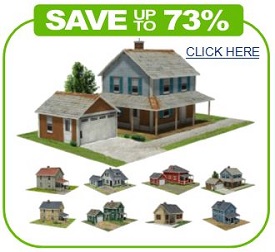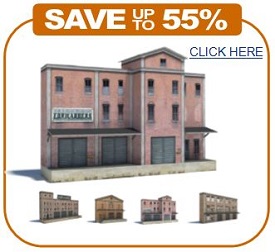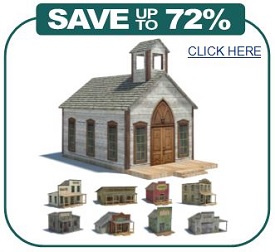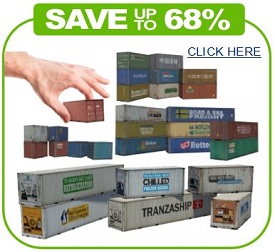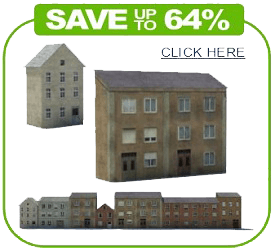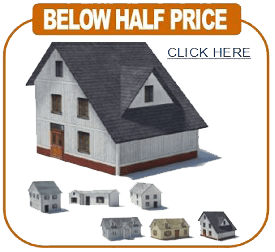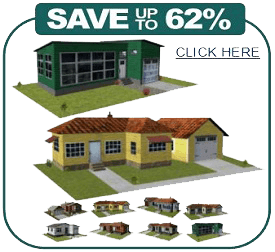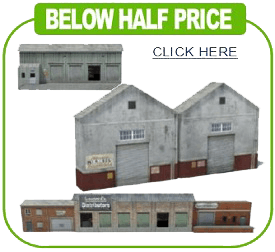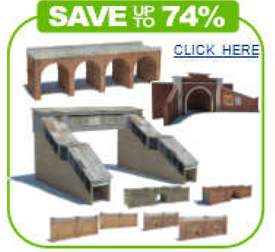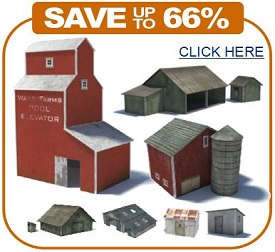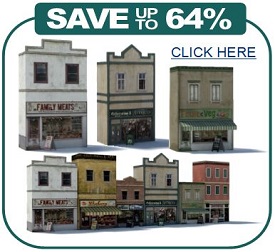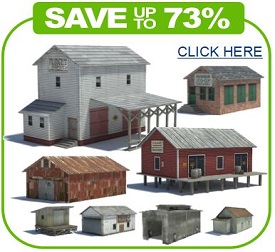200+ “Extraordinarily Real” Printable Paper House Models,
and Replica Background Structures to
Download, Print, and Build for Your Scale Railroad..
If you have an N scale, OO gauge, or HO scale model railroad, or if you are into craft activities, or enjoy creating awesome dioramas, then building house models (and other replica structures for that matter) is something you’ll no doubt be interested in. The good news is; this website has a wonderful selection of printable replica structures, including paper house models, on sale right now.
Take a close inspection of the 200 or more printable paper models for sale from our Home Page and you’ll no doubt be impressed with the exceptionally high standard of weathering and detailing evident on each design. After selecting the designs you want; the full color plans for each model can be downloaded, printed out, and glued to recycled cereal box card or corflute. The cardboard / corflute pieces will then be ready for assembling into “authentically real” miniature replica structures in OO scale, N scale or put together as HO scale buildings.
Thanks to These Clever Paper House Models –
Building Model Houses Has Never Been Easier or More Fun!
Whether you are an experienced model railroader, a wargamer, an arty craftsperson, someone who likes making dioramas, or a student completing a school project – the paper house models on sale here are certainly worthy of serious consideration. After putting a couple together, you’ll be intrigued with precisely how durable and strong they are when constructed. Unquestionably you will derive years, if not decades of pleasure from them. What’s more, you’ll be able to construct these “real-looking” paper replicas (glued on carboard) to HO scale, OO scale, or assemble them as N scale buildings.
Assembling these paper house models will seem like a piece of cake when compared to all the things that can go wrong when building a real full-sized dwelling. Some of things that can go wrong when constructing a real world home include: mistakes in ordering or delivering custom orders of materials; confusion with the blueprints or house plans; delays caused by weather, labor, or other factors; unforeseen construction costs or blowouts, interval financing loans, builder or contractor mistakes; contractors wanting for payments upfront; missing contracts; and simple (sometimes expensive) design flaws.
When a real full-size property is completed the problems don’t necessarily finish there. Newly completed dwellings can suffer from ongoing problems with: shrinkage cracks; truss rises; nails popping, moisture and condensation issues (yes even in a new home); condensation in between window panes, wet garages, basements and crawl spaces; issues with grading and drainage; and balancing the cooling and heating system. The list of problems with new builds can go on.
I don’t want to put you off constructing a brand new full size home, because generally most things work out okay, and most homeowners and new homebuyers are thrilled with their purchases. However life in the miniature world of building model houses is a lot less complicated and the process from start to finish is much faster. Most of the paper house models on sale here can be constructed in about an hour or so, as there is no painting, airbrushing, or skilled weathering needed to finish the scale models to a very high standard.
Planning One Step at a Time – 8 Steps to a Better Model Railroad Layout
Mistakes can be costly so take your time and work through the process carefully, logically and thoroughly. After all, buying a train set or building a layout is not a race. It is better to think things through carefully and then do things the best way to achieve your goals.
With that in mind I have put together this list of steps to help you on this exciting journey. You don’t necessarily need to work through them in this order, but you will want to consider each step:
Step 1: Make Small Mistakes First
We all make mistakes especially when we are learning. So, with this in mind it’s usually best to start small. Then hopefully, mistakes can be small too. You will probably want to purchase only a small amount of track to start off and maybe some plugs, switches, an locomotive engine or two, and a few cars. A small track layout of 4×8 or less might be a good place to start. There is no point in being intimidated (and maybe discouraged) by a large or complex set when you are learning the basics. With a smaller set it will be easier to fix mistakes or make changes. HO scale is the most popular model railroading size in the USA and many other countries, but the UK equivalent being OO scale (OO gauge) is number one in Britain and throughout many European countries. N scale railroads are very popular for those train modelers with limited space to allocate for their layout. If you look above you will see there are many plans of sale for building house models, railroad structures of various kinds, and several printable paper plans for making railway backdrop structures.
A 4×8 layout is large enough to fit the 18-inch radius curves that come with many train sets. With a 4×8 layout there is also room for an oval with 18-inch radius ends and a few sidings.
You can always add accessories and upgrade your set as you go along.
By not going overboard at the beginning, you give yourself a chance to see what you need to make it even better.
Step 2: Buy a Kit (Starter Set)
Although not for everyone, boxed model train sets have everything you need to get started in one complete package… and they’re usually very reasonably priced. Starter kits can be a wonderful entry level for beginners. They include: enough tracks for a basic layout, a locomotive, some rolling stock and a power pack. Those are the basics to get up and running.
Talk with the staff at your local hobby shop because they can advise you on the best selection to meet your needs. Buying a starter kit doesn’t necessarily mean you have to compromise on quality. There are a number of really good kits out there to choose from. As you progress you will become more selective and discerning with improved knowledge and clarity of what you what you want to achieve, and what aspects of the hobby you most enjoy.
Downloaded paper house models and other plans are a low cost way to create a real looking scene complete with scale buildings and structures. Plastic model kits are also very good, but require painting and airbrushing skills to come close to the same quality, and they are considerably more expensive.
Step 3: Know Your Budget
Model train sets can start from a few dollars, but a complete layout can run into several thousands dollars, so it is important to decide how much you want to spend. Set a realistic budget and stick to it.
Thanks to the internet and sites like “e-bay” you can pick up some real bargains in the second hand market. Make sure you know exactly what you are buying, especially if they are pre-used.
When you’re in the hobby shop it can be very easy to blow your budget so it’s best to decide your limits before you shop. This will ensure that you don’t blow your budget when you spot that perfect (but very pricey) train set or accessory. Again it is matter of balancing ambition with realistic objectives. The same considerations apply to how much time you can allocate to building your layout. Many a layout has gone unfinished due to lack of time and money.
Building model houses and other HO scale structures like bridges, tunnel portals, backdrop railway yard warehouses can be done using paper house models and plans that are downloaded and printed on paper, before adhering the designs to card for assembly. These not only look convincingly real, but they are also remarkably strong and long lasting, apart from being very inexpensive to buy.
It is all about getting value for money without going overboard. When starting off you won’t need the most expensive… but nor should you buy a poor quality cheap model train set from a discount store. You want pleasure from running your trains… not frustration.
Talk with model railroading veterans about this hobby and many will tell you they still have their very first train set. They’ll also tell you how much fun they’ve had with it. So choose carefully.
Step 4: Research What’s Available
Before purchasing an HO scale train set (OO, or N scale), do your own research to familiarize yourself as to what’s available. Surf the net and study the videos and tutorials in the members area of the online model train club. Search for information on the trains and printed paper house models that most interest you.
Surfing the internet you’ll see that a lot of sites specialize in certain aspects of model railroading or different scales such as HO scale, N or OO scale. Many of these sites offer in-depth information and excellent tips and ideas that will help increase your knowledge and stimulate your creative juices.
This website specialises in selling plans for printable scale model buildings. There are more than 200 unique designs to download, print and build to HO scale, to OO gauge, or N scale if you have a smaller railway. The Home Page catalog has an extremely wide variety of background buildings, bridges, miniature scale model shipping container designs, replicas of old wild western town buildings, railway structures of varying styles, as well as an excellent selection of paper house models to download.
Step 5: Where is Your Layout Going to Live?
Before you purchase your train set think carefully about where you’re going to display and built it. Select a space where it won’t get damaged… and where you have room to enjoy the set… and work on… and operate the electric trains with ease. And, if possible, room enough to expand onto your electric train set. Yes, that’s something to consider – is it going to be permanent, or is the railroad layout going to put away after each use?
Locate your layout with care. The amount of available space you have will influence what you end up modeling. There is no point in trying to build an electric train layout with several scale model railway stations, goods yard, bridges and villages etc., if it needs to be cramped into the corner of the spare bedroom. Not that you can’t be ambitious as long as you are realistic.
A table or a simple raised platform usually works well. You can make a platform by placing some plywood on a pair of saw-horses or some other raised support. The train will run a lot better if it’s secured to a hard surface like plywood. It is also better to be raised to a comfortable height above the floor.
The scale model buildings for sale here can be purchased in OO / HO scale or N scale to suit individual requirements. Furthermore, the plans for these paper models can easily be scaled down further in size if smaller model buildings are required. Sometimes slightly smaller structures are required for railroad backdrops, so scaling the plans for printable paper models is a very handy consideration.
It’s usually best not to display your model train set on the floor. Carpet and rails don’t mix because being low to the floor your set will attract pet hair, dirt, dust and debris that can stick to the train tracks and get into the locomotive engine. The floor is not a good location, because pets, or children might damage the train set or the scale model buildings you have printed and constructed. Trains and models on the floor may even cause someone to trip and/or get injured.
When locating your railway or train layout make certain that the site has a good electrical supply for running the trains and lighting your layout. It must be dry and comfortable to work in all year round.
Keep in mind that it’s likely the railroading bug will bite you. It is contagious! So, you’ll need to have you room for expansion.
Step 6: Select your Scale Carefully
Choose the scale you want to work with carefully. Make sure that you have enough room to accommodate a railway layout in that scale size. Also, decide how big you want your layout to be now and in the future. If you think you might want to expand your layout in the future, then you may want to start off with a scale that takes up less space.
Many people get started with HO scale, but what you choose is over to you. If space is an issue, then N scale might be a better option than HO scale. N scale takes up less room than HO. As a comparison, you can fit as much detail into an N scale layout using a door as your platform, as you can on a 4 by 8 sheet of plywood with HO.
Don’t just allow the required space for operating your trains, but also consider how much space will be needed to create scenery features such as mountains, streams, and roads. Then you’ll need space for your scale building models and structures including bridges, shops, industries, loading docks, and paper house models. Fortunately you can save considerable space by using background buildings like the ones for sale in our online store. That require very little space when compared to the equivalent structures made in 3D
Step 7: Select a Theme for Your Railway
Model railroading offers so many different options, that it sometimes pays to stick with a theme. Perhaps select an historical era that you are interested in and then select your trains, building and scenery from that era. For example: a layout depicting California logging railroads in the 1920s might interest you.
Researching a theme can be particularly enjoyable by adding to the fun and also making the train layout seem more realistic. For example, a street from the old wild western days would have a lot of possibilities for recreating a fascinating piece of US history with old west models such as a sheriff office, saloon, blacksmiths stable, and Wells Fargo stage depot. Plans to make an old wild west town can be purchased and downloaded here. You can construct the paper models to HO scale, or build them to OO gauge, or N scale. Add some miniature plastic cowboys and horses and you will have depicted an interesting replica scene from the old wild western day of US history. You can expand your wild west scenery by adding a mining town depicting gold rushes that happened in the latter half of US history. Mining town model buildings are also on sale here.
Okay, assuming you have a favorite period in railway history, then you might want to base your layout around that. The alternative is to cover a wider time frame. Think carefully about what time scale you want to model.
The most popular time frame is the steam era. A wide range of rolling stock and scenic accessories are available in both the new and secondhand markets. One thought is to build your layout to cover the transition period from late steam to early diesel. This would give you the best of both worlds. You could run the very latest rolling stock, along side steam if you include a branch preservation line in your layout.
Step 8: Do Even More Research
Search the internet for online model train retailers and find out as much information as you can online. Re-visit the hobby shops in person (spend an hour or so in each) and ask more questions. Shop around and then shop around some more.
The more you know about model trains, the less chance that you’ll be taken for a ride (excuse the pun!). Some shop assistants and internet retailers just want to sell… and others may misunderstand your needs and sell you the wrong thing. However, in saying that, in general hobby shop employees and online retailers have a wealth knowledge and are happy to share their ideas. Also the more research you do, the better you’ll get to know your train scales, styles and which manufacturers you prefer.
Toy stores sometimes carry electric train sets, but often they specialize in the lower end or battery operated market. Hobby stores are generally more specialized and cater more for the experienced enthusiasts. They sell more challenging electrical model trains sets and offer choices from more manufacturers than do most toy stores. The other advantage is that hobby shops typically service what they sell. Although there are exceptions, hobby stores generally have shop staff who are knowledgeable about model trains.
I hope this was helpful. Have ago making paper model houses and other miniature scale model structure replicas. You can download the plans for over 200 paper models on sale from this website. Build then from cardstock or corflute, and give them pride of place on your model railroad.

